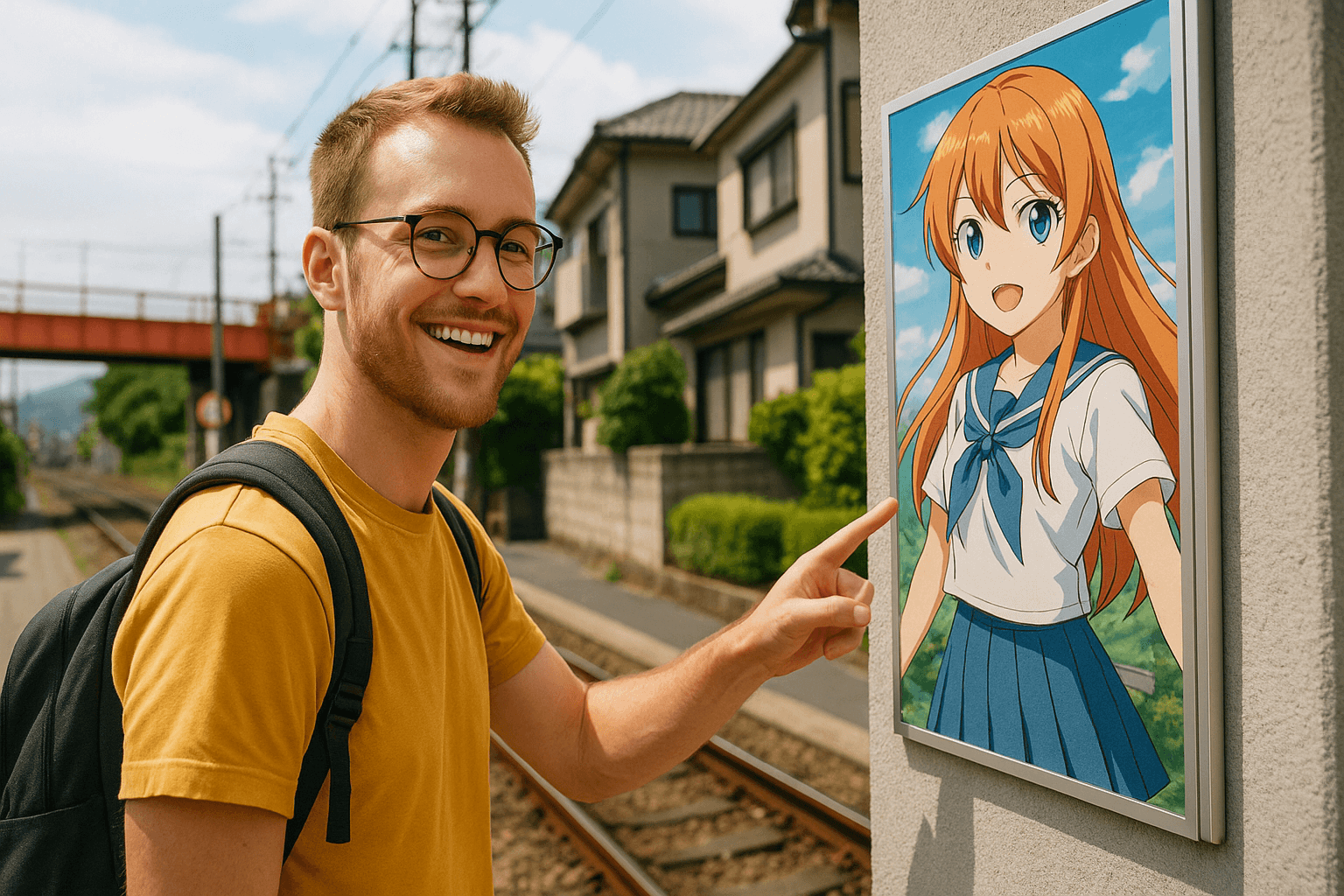Anime isn’t just a form of entertainment in Japan—it’s a cultural force that has shaped fashion, tourism, and even religion. In recent years, fans from around the world have traveled to Japan not only to shop for figures and manga but also to visit real-life locations that inspired their favorite series. This trend, often called seichi junrei (holy land pilgrimage), has turned shrines, towns, and even train stations into pop-culture landmarks.
If you’ve ever dreamed of walking the same streets as your favorite characters, this anime pilgrimage Japan guide is for you. From the electric streets of Akihabara to the quiet shrines of Saitama, here are the top pilgrimage spots every anime and manga fan should visit, plus tips to make your journey unforgettable.
- Akihabara, Tokyo – The Otaku Capital
- Ikebukuro, Tokyo – Female Otaku Heaven
- Kyoto Toei Studio Park – Live the Samurai Anime
- Hakone – Evangelion’s Real-Life Setting
- Washinomiya Shrine, Saitama – Lucky Star
- Oarai, Ibaraki – Girls und Panzer
- Shirakawa, Gifu – Higurashi: When They Cry
- Dogo Onsen, Ehime – Spirited Away
- Sapporo, Hokkaido – White Album and More
- Fujisawa & Kamakura, Kanagawa – Slam Dunk and Blue Period
- Tips for Anime Fans Visiting Japan
- Conclusion
Akihabara, Tokyo – The Otaku Capital
Why Visit
Akihabara is ground zero for anime culture. Known as “Electric Town,” this district is filled with anime shops, maid cafés, arcades, and specialty stores that make it a must-visit for otaku.
Highlights:
- Animate Akihabara: Multi-floor megastore with manga, Blu-rays, merch, and limited-edition goods.
- Mandarake Complex: Paradise for secondhand manga, rare figures, and collector’s items.
- Akihabara UDX & Crossfield: Featured in series like Steins;Gate.
- Maid cafés: Quirky themed cafés where waitresses dress as anime maids.
How to Get There
Take the JR Yamanote Line or Tokyo Metro Hibiya Line to Akihabara Station. Exit the Electric Town gate to step right into the heart of anime culture.
Ikebukuro, Tokyo – Female Otaku Heaven
Why Visit
While Akihabara is more male-oriented, Ikebukuro has become a hub for female fans and BL (Boys’ Love) culture. Sunshine City and the Otome Road area are packed with shops catering to fujoshi (female fans of yaoi/BL).
Highlights:
- Animate Ikebukuro Flagship Store: The biggest Animate in Japan, newly expanded with event spaces and cafés.
- Otome Road: Street lined with doujinshi shops, cosplay stores, and BL specialty shops.
- Pokémon Center Mega Tokyo (Sunshine City): A must for Pokémon fans.
- Butler cafés: A classy counterpart to maid cafés.
How to Get There
Take the JR Yamanote Line, Seibu Ikebukuro Line, or Tokyo Metro Marunouchi Line to Ikebukuro Station. Sunshine City is about a 10-minute walk east.
Kyoto Toei Studio Park – Live the Samurai Anime
Why Visit
Kyoto’s Toei Uzumasa Eigamura is a working film set and theme park where many historical dramas are filmed. It’s also a hotspot for anime like Rurouni Kenshin and Samurai X fans. You can dress up as a samurai or ninja and wander through Edo-period streets that feel straight out of an anime.
Highlights:
- Anime exhibits: Toei’s animation studio showcases Dragon Ball, Pretty Cure, and One Piece.
- Live ninja shows: Action-packed performances perfect for anime fight scene lovers.
- Cosplay opportunities: Rent costumes and immerse yourself in historical anime vibes.
How to Get There
From JR Kyoto Station, take the San-in Line to Uzumasa Station or Keifuku Line to Uzumasa-Koryuji Station. The park is a short walk away.
Hakone – Evangelion’s Real-Life Setting
Why Visit
Fans of Neon Genesis Evangelion know that the futuristic city of Tokyo-3 was modeled after Hakone, a hot spring resort area west of Tokyo. Today, Hakone fully embraces its anime fame with themed buses, signage, and merchandise.
Highlights:
- Evangelion Store Hakone: Exclusive Eva merchandise.
- Owakudani Valley: Volcanic landscape reminiscent of battle scenes.
- Lake Ashi & Hakone Shrine: Iconic backdrops from the series.
- Eva-themed attractions: Posters, decorations, and even vending machines.
How to Get There
From Shinjuku Station, take the Odakyu Romancecar to Hakone-Yumoto. Local buses and the Hakone Tozan Railway connect you to attractions.
Washinomiya Shrine, Saitama – Lucky Star
Why Visit
This otherwise quiet shrine in Saitama shot to fame thanks to the slice-of-life series Lucky Star. In the anime, the characters visit Washinomiya Shrine for New Year’s, and fans have been flocking ever since.
Highlights:
- Anime pilgrimage ema: Wooden prayer plaques decorated with fan art left by visitors.
- Annual Lucky Star Festival: A summer matsuri that blends local tradition with otaku culture.
- Peaceful shrine grounds: A balance of spiritual tradition and anime fandom.
How to Get There
Take the Tobu Isesaki Line to Washinomiya Station. The shrine is about a 10-minute walk.
Oarai, Ibaraki – Girls und Panzer
Why Visit
The seaside town of Oarai became a pilgrimage spot after it was featured in the anime Girls und Panzer. Fans flock to see real locations used in the show, from the shopping street to the Oarai Marine Tower.
Highlights:
- Ōarai Isosaki Shrine: Its torii gate overlooking the ocean appears in the series.
- Ōarai Marine Tower: Observation deck and exhibition spaces with Girls und Panzer displays.
- Local shops: Many decorate with anime posters and themed goods.
How to Get There
From Mito Station (JR Joban Line), take the Kashima Rinkai Railway Oarai Line to Oarai Station.
Shirakawa, Gifu – Higurashi: When They Cry
Why Visit
Fans of horror anime will recognize Shirakawa’s traditional gassho-zukuri farmhouses as the inspiration for Higurashi no Naku Koro ni. The village’s quiet, idyllic atmosphere contrasts chillingly with the anime’s storylines.
Highlights:
- UNESCO World Heritage Site: The real-life beauty of the farmhouses is stunning in all seasons.
- Fan signs and maps: Some shops mark anime connections.
- Seasonal events: Nighttime illuminations create an eerie, atmospheric vibe.
How to Get There
Take a bus from Takayama Station (JR Takayama Line) or Kanazawa Station. The ride takes about 1.5–2 hours.
Dogo Onsen, Ehime – Spirited Away
Why Visit
The iconic bathhouse in Studio Ghibli’s Spirited Away was partly inspired by Dogo Onsen Honkan in Matsuyama, Shikoku. This historic hot spring has been welcoming bathers for over 1,000 years.
Highlights:
- Dogo Onsen Honkan: A wooden bathhouse that feels like stepping into Hayao Miyazaki’s world.
- Nearby shopping arcade: Filled with local snacks and Ghibli-inspired goods.
- Botchan Train: Nostalgic railway also featured in Japanese literature and anime culture.
How to Get There
From JR Matsuyama Station, take the Iyotetsu tram to Dogo Onsen Station (about 20 minutes).
Sapporo, Hokkaido – White Album and More
Why Visit
Hokkaido has been the backdrop for many anime, including White Album and Golden Kamuy. Sapporo’s snowy streets and famous clock tower appear in multiple works.
Highlights:
- Odori Park & Sapporo TV Tower: Frequently shown in anime set in Hokkaido.
- Snow Festival: An anime-friendly event where snow sculptures often depict popular characters.
- Golden Kamuy pilgrimage: Explore Ainu culture, central to the series.
How to Get There
Fly to New Chitose Airport from Tokyo (90 minutes). Sapporo is 40 minutes away by train.
Fujisawa & Kamakura, Kanagawa – Slam Dunk and Blue Period
Why Visit
Sports anime fans know the iconic seaside scenes of Slam Dunk, especially the Kamakura Kōkōmae Station crossing. Recently, Blue Period also highlighted art school life in Tokyo and Kanagawa, inspiring fans to visit.
Highlights:
- Kamakura Kōkōmae Station: Instagram-worthy location with the ocean backdrop.
- Enoshima Island: Featured in many anime for its scenic coastline.
- Tsurugaoka Hachimangu Shrine: Adds cultural depth to the area.
How to Get There
Take the Enoden Line from Fujisawa Station to Kamakura Kōkōmae Station.
Tips for Anime Fans Visiting Japan
- Plan around festivals: Many pilgrimage spots host annual anime events, from Lucky Star’s shrine festival to Girls und Panzer parades.
- Respect local customs: Remember that shrines and temples are sacred spaces. Be polite when taking photos.
- Collect stamps: Some locations offer unique stamps or pilgrimage books (like a real henro pilgrimage).
- Budget time: Anime spots are scattered across Japan. Combining them with regional sightseeing (like hot springs, castles, or food tours) makes the trip more rewarding.
- Use rail passes: The JR Pass or regional rail passes save money if you’re traveling widely.
- Bring cash: Rural pilgrimage sites may not accept credit cards.
- Check local anime stores: Many towns sell exclusive goods you won’t find in Tokyo.
Conclusion
Anime has transformed ordinary streets, shrines, and towns into cultural landmarks that attract fans from around the globe. Whether you’re wandering Akihabara’s neon alleys, soaking in Dogo Onsen, or standing at the seaside crossing from Slam Dunk, each spot offers a chance to connect with your favorite stories in real life.
This anime pilgrimage Japan guide has highlighted some of the most iconic destinations, along with practical tips to help you get there. From Tokyo’s buzzing hubs to Shikoku’s quiet onsen towns, these pilgrimages let you blend travel with fandom—creating memories as vivid as any scene in anime.
So grab your JR Pass, pack your camera, and get ready to step into the worlds of your favorite series. Your otaku adventure in Japan is waiting.

